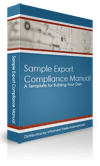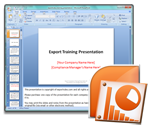Export Compliance Legends and Markings
Notice anything missing?
Legends and Markings
If you have been in the business of exporting for any length of time, no doubt you have noticed that folks don’t pay much attention to marking their documents. Now I have seen a marked increase in the Company Proprietary legend, but the words Export Controlled seem to evade the Header and Footer comment box. While noting that the information contained in the export legally belongs to the company you work for, not correctly marking it with the proper export legend can invite unwanted trouble to your front door.
One instance I was involved in over my tenure as an Empowered Official caused me weeks of anguish. Despite my efforts, the company I was working for at the time was not all that good at paying attention to proper legend etiquette. Well, a drawing of a product listed on the United States Munitions List was sent to a vendor incorporated in the U.S. Unfortunately, no one asked if that vendor had a manufacturing facility abroad. You guessed it, they did! So the innocent forwarding of an ITAR-controlled drawing sent between two U.S.-incorporated companies ended up on a fax machine overseas.
During a casual conversation with the U.S. facility, they happened to mention the faxing incident and my red flag indicator went straight up. I asked the obvious question, “Do you have an export authorization to send our drawing to your foreign manufacturer?†You guess it again, the answer was, “Huh?†Yes, I spent the next several weeks on the phone with their corporate lawyers and my corporate lawyers gently coaxing them into a “voluntary†disclosure.
You may have asked yourself how does this relate to putting the proper restrictive legend on a document. Well, the other company tried to draw mine into the disclosure based on the fact that the drawing was not properly marked as ITAR-controlled. We responded by confirming this fact and that we would be stepping up our compliance in this area, but as a registered defense contractor in the United States, they had to abide by all the same laws and regulations under the Arms Export Control Act as we did. While marking a fax, email or document may not be the law, it is smart business practice.
No, we did not commit an export violation, but how much angst, time and money do you think would have been saved by simply adding the words ITAR-CONTROLLED?
I have also had the experience of seeing documentation marked incorrectly with an ITAR restriction and the information therein was controlled by the EAR. The comment heard around the world is, better safe than sorry. Not necessarily so, I say! If you claim that the data is controlled by the Department of State and then turn around and export the article it relates to under the jurisdiction of the EAR with a corresponding Export Commodity Classification Number (ECCN), this is obviously contradictory.
Should you have a case (purely hypothetical) whereby you are involved in a Voluntary Disclosure with the State Department and among your mitigating factors includes the fact that you classified the data as commercial and your drawing contains a restriction on the part of the ITAR (again, to be safe), this tends to make you look a little less bright than you should be.
If what you are exporting is under the jurisdiction of the ITAR or the EAR, the moral of the story is proper due diligence and proper legends.
Sue K. MacDonald-Nans
SRCTec, Inc.
Posted on April 14th, 2008 by keeton
Filed under: EAR, ITAR


If our customer doesn’t notify us that the product is ITAR but they do specify a DPAS rating is it safe to assume it falls under ITAR?
Unfortunately, the burden of compliance is on you. Regardless of the information your customer passes on to you, it is your responsibility to A) determine whether the product falls under ITAR jurisdiction and B) how remain compliant in handling that item.